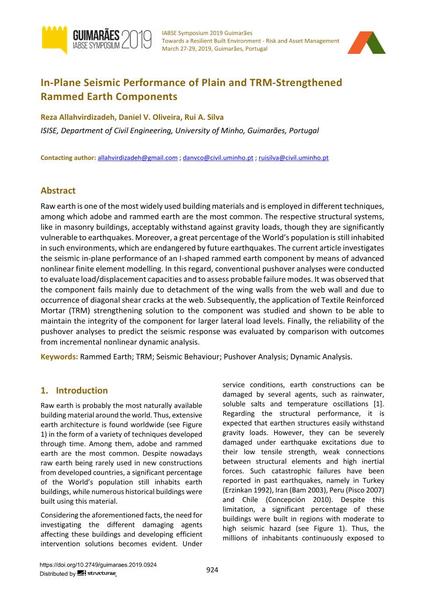In-Plane Seismic Performance of Plain and TRM-Strengthened Rammed Earth Components

|
|
|||||||||||
Détails bibliographiques
| Auteur(s): |
Reza Allahvirdizadeh
(ISISE, Department of Civil Engineering, University of Minho, Guimarães, Portugal)
Daniel V. Oliveira (ISISE, Department of Civil Engineering, University of Minho, Guimarães, Portugal) Rui A. Silva (ISISE, Department of Civil Engineering, University of Minho, Guimarães, Portugal) |
||||
|---|---|---|---|---|---|
| Médium: | papier de conférence | ||||
| Langue(s): | anglais | ||||
| Conférence: | IABSE Symposium: Towards a Resilient Built Environment Risk and Asset Management, Guimarães, Portugal, 27-29 March 2019 | ||||
| Publié dans: | IABSE Symposium Guimarães 2019 | ||||
|
|||||
| Page(s): | 924-931 | ||||
| Nombre total de pages (du PDF): | 8 | ||||
| DOI: | 10.2749/guimaraes.2019.0924 | ||||
| Abstrait: |
Raw earth is one of the most widely used building materials and is employed in different techniques, among which adobe and rammed earth are the most common. The respective structural systems, like in masonry buildings, acceptably withstand against gravity loads, though they are significantly vulnerable to earthquakes. Moreover, a great percentage of the World’s population is still inhabited in such environments, which are endangered by future earthquakes. The current article investigates the seismic in-plane performance of an I-shaped rammed earth component by means of advanced nonlinear finite element modelling. In this regard, conventional pushover analyses were conducted to evaluate load/displacement capacities and to assess probable failure modes. It was observed that the component fails mainly due to detachment of the wing walls from the web wall and due to occurrence of diagonal shear cracks at the web. Subsequently, the application of Textile Reinforced Mortar (TRM) strengthening solution to the component was studied and shown to be able to maintain the integrity of the component for larger lateral load levels. Finally, the reliability of the pushover analyses to predict the seismic response was evaluated by comparison with outcomes from incremental nonlinear dynamic analysis. |
||||
